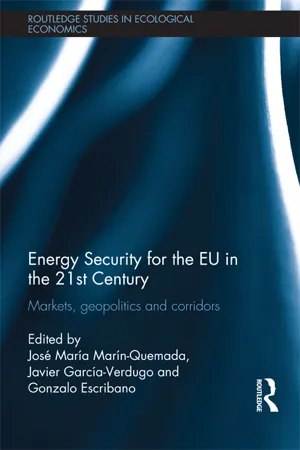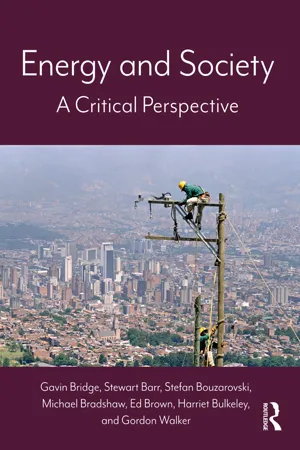Geography
Energy Supply
Energy supply refers to the provision of energy sources such as electricity, natural gas, and renewable energy to meet the demands of society. It encompasses the production, distribution, and consumption of energy, and is crucial for powering industries, transportation, and households. The availability and sustainability of energy supply have significant implications for economic development and environmental sustainability.
Written by Perlego with AI-assistance
Related key terms
3 Key excerpts on "Energy Supply"
- eBook - ePub
Geopolitics of Energy in Central Asia
India's Position and Policy
- Ramakrushna Pradhan(Author)
- 2020(Publication Date)
- Routledge India(Publisher)
In a world of rapid progress and fast-paced industrialization, energy occupies the top priority. Therefore, to ensure timely, adequate, reliable and cheap energy, its secure and easy availability is of the utmost importance. Only this can enable the country to sustain its economic growth, maintain its society’s lifestyle and feed its military needs. For that, competition plays a major role, because most of the world’s principal energy producers are not principal consumers. For them, the concept of the geopolitics of energy arises, revolving around who supplies it, as securing reliable access to those supplies has been a driving factor in global prosperity and security. The structural dimensions of energy geopolitics can be seen from both the supply and demand sides. The supply side includes the volumes of global reserves, their distribution patterns, their longevity, the discoveries, capacity building and so on. On the demand front, the issues are related to the market size and its geography, logistics of transport and its delivery and others.The geopolitics of energy in today’s world principally revolves around oil and gas and to a lesser degree around nuclear and hydroelectricity sources, of which oil and gas are essentially geopolitical commodities. Since the availability of hydrocarbons is determined by geology, the global politics of energy is shaped mainly by the “arc of energy”, stretching from the Gulf region to the Caspian Sea, through Siberia and the Arctic region to the Russian Far East, Alaska and Canada. In this regard, it can be said that nearly 80 per cent of the world’s oil and gas including potential reserves are located in this region (Sikri 2008: 2).Nevertheless, factors like economics, technology and politics played critical roles in determining the supply and demand side of the energy geopolitics. For the energy-producing countries, energy is not only a source of enormous power and wealth, it also constitutes leverage. Since energy is a strategic resource, denial of it to any rival or enemy increases the latter’s vulnerability.The political nature of energy linked to the sources of supply and demand comes to public attention at moments of crisis. But energy politics has become yet more complex as transport systems particularly in the United States, Europe, China and India have become largely reliant on oil. Access to energy remains critical to sustaining growth in China and India – not just to keep pace with the burgeoning population. Failure to deliver on the hope of greater prosperity could unravel authoritarian regimes and even democratic ones, as the populace becomes more educated and demanding. And it is these very factors that have turned the market power of energy suppliers into political power. Importers have come to compete for supplies, driving up prices, suppliers’ wealth and the capacity to play roles in regional and international politics. - eBook - ePub
Energy Security for the EU in the 21st Century
Markets, Geopolitics and Corridors
- José María Marín Quemada, Javier García-Verdugo, Gonzalo Escribano(Authors)
- 2012(Publication Date)
- Routledge(Publisher)
Part IEnergy, geopolitics andenergy securityQualitative and quantitative analysisPassage contains an image
1Global energy needs and resources Geographical imbalances and energy securityJavier García-Verdugo and Laura RodríguezThere is no further need to stress the importance of energy for the global economy. It is critical however to be aware that any policy decisions about energy should be based on a sound knowledge of the facts about the international energy industry. Apart from the strictly technical aspects of energy sources (calorific factors, production technologies, pollutants content by fuel and so on), the other fundamental feature of global energy is the unbalanced geographical distribution of reserves, production and consumption, so that international energy-related trade flows become essential for the energy security (see Chapter 2 ) of most countries.This chapter will briefly review the basic statistical data of the world energy system – world energy demand, production and reserves – with a breakdown in each case by energy sources and by regions. We will begin with energy demand, since it can be argued that the energy industry – the activities of exploration, production, transport and distribution – follows the path set by energy consumption, which in turn is highly dependent on economic growth. Energy production patterns and fossil fuel reserves will be explored next. Finally, an analysis of international energy trade will connect supply origins with demand centres and will provide the basis for the in-depth analysis of energy corridors and energy security carried out in the rest of the book. The interaction between energy production and demand determines the short run equilibrium of the system, while the long run situation depends on the rate of growth of energy consumption and the expected variation in reserves. - eBook - ePub
Energy and Society
A Critical Perspective
- Gavin Bridge, Stewart Barr, Stefan Bouzarovski, Michael Bradshaw, Ed Brown, Harriet Bulkeley, Gordon Walker(Authors)
- 2018(Publication Date)
- Routledge(Publisher)
outputs of the way energy systems are organised: the commissioning of hydro-electricity plants or the development of biofuel plantations, for example, reflect expectations about the scale and pattern of future energy use; prevailing social norms and routines (working, travelling, leisure) that create demand for energy services and govern the acceptability of different energy options; and the actions (and inactions) of governments and investing companies to guide and deliver investment in energy infrastructure. Resource landscapes are simultaneously, therefore (i) supply zones from which societies derive their energy needs; and (ii) spaces shaped the unequal distribution of economic and political power within society, and which in term reproduce geographically uneven development. This dual perspective on energy resource landscapes – as spaces of resource provisioning and the exercise of social power – is essential to understand their contemporary significance, and lies at the heart of this chapter.This chapter considers the wide range of materials regarded by society as energy resources in the context of a massive expansion of energy availability since the Industrial Revolution. We explain the dominance of fossil fuel extraction and thermal power generation in the global energy mix, and the distinctiveness of the energy resource landscapes associated with fossil fuels. We introduce the concept of resource quality, and discuss how variations in energy density, energy return on investment, power density and carbon intensity shape energy resource landscapes. And we show how all energy resource landscapes (fossil or renewable, high or low carbon, sustainable or otherwise) have environmental impacts. Throughout, the chapter highlights the contested and political character of energy resources – i.e. how the energy resource landscape can simultaneously be landscapes of loss, violence, and dispossession. All resource landscapes rest on claims to property, and the authority to impose and defend a particular form of land use. Resource landscapes are, therefore, necessarily political: the technologies and organisational forms through which resource landscapes take shape, the places in which they materialise, and the communities whom they do and do not serve, are shaped as much by who is making the decisions and how decisions are made as they are by the laws of thermodynamics or supply and demand.
Index pages curate the most relevant extracts from our library of academic textbooks. They’ve been created using an in-house natural language model (NLM), each adding context and meaning to key research topics.


